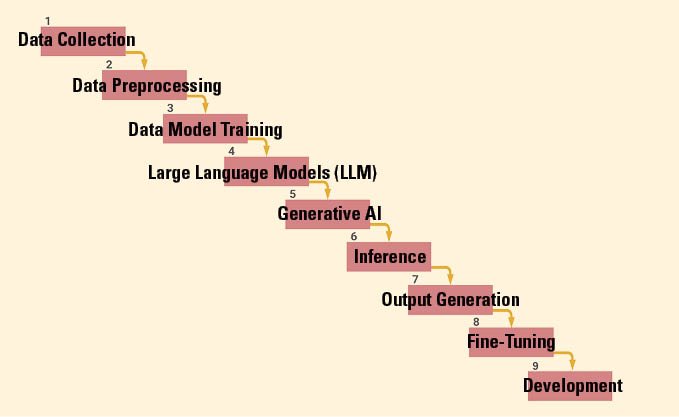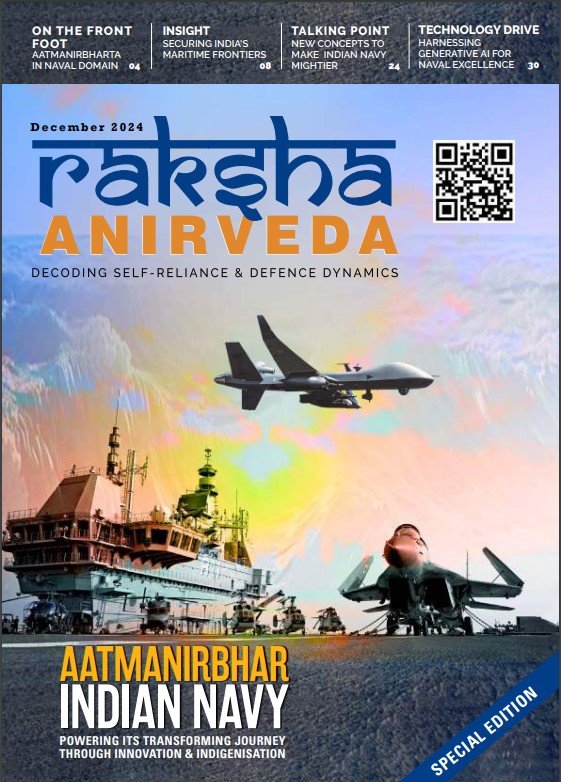In 2021, the book The Human-Machine Team was published, proposing the development of a machine capable of processing vast data sets to identify military strike targets quickly. Initially conceptualised to address bottlenecks in target identification and decision-making, this technology has now become a reality. As modern warfare, intelligence operations, and decision-making processes rapidly evolve, incorporating cutting-edge Artificial Intelligence (AI) technologies has become crucial. The emergence of Generative AI (Gen AI) and advanced Machine Learning (ML) has enabled military forces worldwide to leverage AI for strategic decision-making, improving operational efficiency and real-time battlefield intelligence. Ongoing global conflicts, such as the Russia-Ukraine war and the Israel-Hamas conflict, have underscored the growing importance of AI in modern military strategies. Additionally, AI’s integration into India’s defence operations, particularly through initiatives like Samvaad.Ai for the Indian Navy, demonstrates how AI technologies are transforming military operations, enhancing security, agility, and mission success.
The evolution of Gen AI has paved the way for the development of advanced models capable of generating human-like content, ranging from text and images to music and more. Generative AI has opened new avenues across various sectors, particularly in defence, but also significantly impacting industries like customer service, content creation, and entertainment. A prime example is OpenAI’s ChatGPT, which has revolutionised conversational AI. Its advanced language processing abilities have been widely adopted beyond traditional applications, offering personalised responses, and automating customer interactions. ChatGPT’s impact has extended to businesses seeking to enhance customer support, automate writing tasks, and integrate AI into their workflow to improve efficiency.
One of the significant competitors in this field is DeepSeek, a Chinese firm offering models like R1, which provides robust performance and cost-effective solutions. DeepSeek’s models have garnered attention for their ability to process large datasets and deliver competitive AI services, competing with well-established systems. These models cater to various applications, from natural language processing to sophisticated analytics, making them versatile for use in sectors such as defence, healthcare, and enterprise solutions.
Meanwhile, Ollama offers a practical solution for deploying Generative AI models locally, providing enhanced privacy and control over AI interactions. This platform allows users to run powerful Large Language Models (LLMs) directly on their systems, offering significant advantages in sensitive applications, such as military or financial sectors, where data security is paramount. Ollama facilitates seamless deployment and integration of models like ChatGPT or DeepSeek LLM, ensuring that organisations can maintain complete control over their data, reducing reliance on cloud-based systems and mitigating potential cybersecurity risks.
Understanding Generative AI and Large Language Models (LLMs)
Generative AI refers to algorithms that can create new content, such as text, images, or even music, by learning patterns from large datasets. These systems are designed to understand existing content and generate similar outputs that mimic human-like creativity. In its application, Generative AI is transforming industries by automating content creation, enhancing user interaction, and providing tools for more efficient decision-making. This technology spans multiple areas, from generating text-based content for marketing purposes to creating realistic images or 3D models in defence applications. Within the realm of Generative AI, Large Language Models (LLMs) represent a subset that specialises in processing and generating human language. Trained on massive text corpora, LLMs are capable of understanding and producing text that mirrors human syntax, semantics, and context. Well-known examples include OpenAI’s GPT series and DeepSeek’s LLM. These models are widely applied in areas like natural language processing (NLP), where they enable tasks such as machine translation, chatbots, automated content generation, and more.
The Russia-Ukraine and Israel-Hamas conflicts highlight AI’s growing role in warfare. Russia uses AI-powered drones for precision strikes, while Ukraine leverages machine learning to counter cyberattacks
These models are fine-tuned to meet specific industry needs. For instance, in military applications, LLMs can be used for intelligence analysis, generating reports, summarising documents, or providing automated translations in multiple languages. In defence and aerospace, LLMs can assist in processing vast amounts of data from satellites, drones, and reconnaissance missions, ensuring quick and actionable insights.
Ollama is a platform that supports the deployment of these advanced LLMs and AI models locally, on user-controlled infrastructure. Unlike cloud-based models, which raise concerns regarding data security and potential breaches, Ollama ensures that all AI-driven processes stay within a secure environment. This is particularly beneficial for sectors like defence, where maintaining the integrity and confidentiality of data is critical. Ollama’s solution empowers users to run these models on local hardware, providing a higher degree of privacy, speed, and control over AI interactions. In defence and other sensitive sectors, where data sovereignty is critical, Ollama offers a way to integrate the latest AI technologies without compromising on security. By utilising on-premise or local deployments, users can harness the power of advanced LLMs while ensuring their data remains within the organisation’s control, mitigating risks associated with remote cloud solutions.

AI in Global Conflicts
The ongoing Russia-Ukraine conflict serves as a prominent case study in the integration of AI technologies in modern warfare. Russia has deployed AI-powered drones for reconnaissance and precision targeting, improving the speed and accuracy of its military operations. These drones, capable of autonomous operation, use advanced sensors and algorithms to process real-time data and provide actionable intelligence to military personnel. In contrast, Ukraine has embraced AI for cyber defence, employing machine learning to detect and neutralise Russian cyberattacks. Additionally, Ukraine utilises AI in surveillance systems that analyse satellite imagery and leverage computer vision algorithms to track Russian troop movements and artillery positions, giving the Ukrainian military a tactical advantage.
The AI system, named Lavender, has been used by the Israeli military to identify targets for airstrikes, particularly in the early stages of the Gaza conflict. Lavender was relied upon heavily, processing over 37,000 individuals as potential militant targets, including Hamas and Palestinian Islamic Jihad (PIJ) operatives, some of whom were low-ranking. In many cases, the outputs of Lavender were treated as though they were human decisions.
In addition to Lavender, Israel has deployed other AI systems, The Gospel with the Israeli Intelligence Corps. “The Gospel” analyses large datasets to identify potential targets, such as individuals or structures associated with Hamas and PIJ. This system automates initial target selection and provides recommendations that are then reviewed by human analysts. The integration of “The Gospel” has significantly expedited the targeting process. For example, during the 2021 conflict, around 200 out of the 1,500 targets struck in Gaza were selected by “The Gospel.” By contrast, since October 7, 2023, the IDF has reported striking over 22,000 targets, with “The Gospel” playing a pivotal role in this rapid escalation.
As AI takes on bigger roles in warfare, ethical concerns are mounting. Autonomous systems making life-or-death calls, as seen with Israel’s Lavender, spark debates over accountability. Nations must balance AI’s strategic benefits with humanitarian responsibilities to ensure it’s used responsibly on the battlefield
Tactical Advantage for India
India is rapidly advancing its adoption of AI for defence applications, with a particular emphasis on integrating Generative AI into the Indian Army’s operational framework. Initiatives such as Samvaad.Ai, developed as part of a challenge from the Indian Navy under the IDEX Disc, stand as a model for AI-driven knowledge management and analytical systems. Zenerative Minds, based in Hyderabad, is at the forefront of developing this innovative platform, which could also be deployed not only across other defence and paramilitary forces but also in various other civil domains having data sensitive critical operations. These systems are designed to enhance military decision-making and streamline operations by utilising AI for knowledge management, real-time data analysis, and automated reporting. What sets these systems apart is their flexibility, being on-premises solutions with cloud deployment options, and their ability to handle multi-format data sources, ensuring collaboration, high accuracy, and full security within a controlled environment.

(Courtesy: https://www.newarab.com/analysis/gospel-israels-controversial-ai-used-gaza-war)
Expectations from AI for defence
The integration of AI in India’s defence infrastructure is designed to enhance operational security. By deploying on-premise solutions within secure military data centres, the Indian Army ensures complete control over sensitive data, minimising the risks of data breaches and cyber threats. This approach eliminates reliance on cloud-based data access, significantly enhancing cybersecurity.
The AI system is capable of processing both structured and unstructured data, such as surveillance footage, satellite images, battlefield communication logs, and geospatial intelligence. It integrates diverse data sources including text-based documents (e.g., operational manuals, tactical briefings), audio and video data, and real-time sensor feeds from UAVs, battlefield sensors, and IoT devices. This enables commanders to access a comprehensive, actionable intelligence repository, supporting mission-critical decision-making.
The system enhances battlefield awareness by enabling real-time information retrieval through natural language queries. AI-generated insights optimise logistics, troop movements, and mission strategies, ensuring faster and more accurate decisions. Integration with war-gaming simulations provides scenario-based decision support, allowing commanders to assess various tactical outcomes and refine their strategies.
The AI system automatically generates structured After-Action Reports (AARs), tactical briefs, and risk assessments, streamlining post-mission analysis and strategic planning. These automated reports consolidate critical intelligence, providing high-ranking officials and field commanders with timely, accurate data to enhance decision-making efficiency.
The system incorporates AI-powered military training modules, which tailor training programs based on specific roles, optimising skill development. It also utilises immersive and data-driven learning methods to enhance tactical drills, standard operating procedures (SOPs), and military doctrines. By offering personalised learning paths, it ensures mission readiness and effective knowledge retention.
The AI system enables secure, role-based access to critical data, allowing various Army units (e.g., Infantry, Artillery, Signals, Cyber, and Aviation) to retrieve mission-specific information. It facilitates AI-driven cross-referencing of intelligence, enhancing interoperability and ensuring coordinated military operations through seamless collaboration across branches.

AI plays a key role in continuous threat detection and cybersecurity. It proactively monitors military networks for potential cyberattacks, analysing patterns to detect intrusion attempts and electronic warfare threats. The system helps safeguard critical military infrastructure by adhering to CERT-In standards and other military-grade cybersecurity frameworks, ensuring resilience against cyber warfare and unauthorised access.
In remote military zones, such as mountainous regions or dense forests, deploying AI systems can be challenging. To address this, small-sized GPUs and compact computing units can be integrated into drones or mobile units, enabling real-time data processing on-site. This approach ensures commanders can access AI-powered analytics in isolated or conflict zones, even without cloud-based systems.
AI-integrated computer vision provides automated, real-time analysis of battlefield conditions. Drones equipped with cameras and sensors continuously monitor enemy movements, analyse terrain, and detect potential threats like weapons or vehicles. By combining Generative AI with computer vision, militaries can efficiently monitor vast areas, process visual data, and provide actionable intelligence to commanders within seconds.
The future of warfare is shifting towards integrated combat systems, where AI-driven drones, robotics, cyber capabilities, and human forces work in harmony. This integration allows military forces to act with greater speed, precision, and operational efficiency. India, through initiatives like Samvaad.AI, is at the forefront of this transformation, leveraging Generative AI for battlefield intelligence, strategic planning, and cyber defence.

(Courtesy: www.zenerativeminds.com)
Key Takeaways
The integration of Generative AI and advanced machine learning into the operational framework of the Indian Armed Forces marks a significant advancement in enhancing national security. By utilising AI-powered knowledge management, real-time intelligence, and predictive analytics, the Indian Armed Forces can improve decision-making, operational efficiency, and readiness while maintaining control over its data infrastructure. Platforms like Samvaad.AI exemplify how these technologies can transform military operations, ensuring enhanced agility and mission success. Globally, AI’s impact on defence strategies is clear, as demonstrated by its role in ongoing conflicts like the Russia-Ukraine war and the Israel-Hamas conflict, where AI has been used to improve targeting accuracy, operational speed, and strategic decision-making. However, the rapid adoption of AI in military operations also presents critical ethical concerns, particularly with regard to humanitarian implications and the potential for autonomous systems to make life-or-death decisions.

As AI technologies continue to evolve, it is essential for nations to implement robust ethical frameworks to balance the strategic advantages of AI with the responsibilities that come with using such technologies in warfare. The increasing deployment of LLMs, AI-driven drones, and other systems further highlights AI’s potential in transforming defence systems. However, the growing use of AI also necessitates careful regulation and oversight to ensure that it contributes to global security while upholding international humanitarian standards. As India and other nations embrace AI for defence, integrating ethical considerations into the development and deployment of AI systems will be key to ensuring that these advancements are used responsibly and effectively.
–The writer is an SME and independent consultant in military technology. The views expressed are of the writer and do not necessarily reflect the views of Raksha Anirveda






